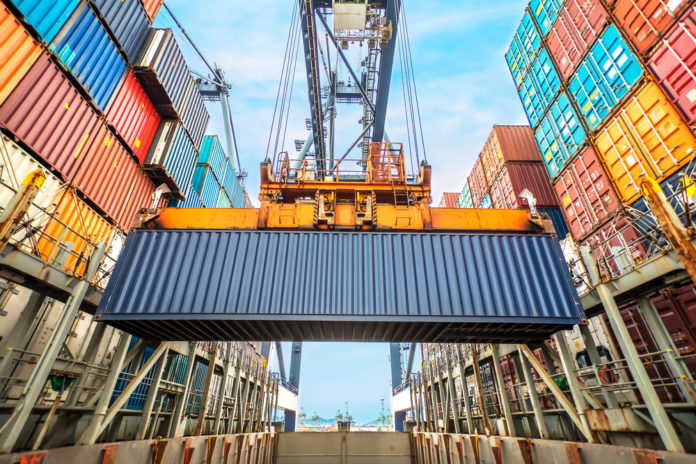The short-term prognosis for the container shipping industry looks poor with global trade depressed and showing little sign of an upturn.
Demand suppressed through economic uncertainty and capacity increases causing a trickle-down effect from the larger to smaller trades as vessels are cascaded from the main east/west routes is expected to be subdued throughout this year and next year.
Forecasts from the Organization of Economic Co-operation and Development (OECD) point to challenging conditions for trade with the trade war between the US and China, uncertainties over the UK’s departure from the European Union and most recently an increase in tensions causing disruption to trade in the Middle East and Gulf region.
The OECD says that global growth slowed to around 2.9% in 2019 and is expected to remain at around the 3% level for this year and next year, it is “the weakest pace [of growth] since the financial crisis,” in 2008.
Further warnings issued by the OECD in the second of its biannual macroeconomic reports, issued in November last year, that growth could slow further if “downside risks materialise or interact, including from a further escalation of trade and cross-border investment policy restrictions, continued uncertainty about Brexit, a failure of policy stimulus to prevent a sharper slowdown in China, and financial vulnerabilities from the tensions between slowing growth, high corporate debt and deteriorating credit quality.”
The bleak economic outlook will interact with the substantial supply-side increase in cargo carrying capacity in the container shipping industry which could see increased pressure on already depressed freight rates.
Danish Ship Finance (DSF) reports that the post-Panamax fleet, that is ships larger than 12,000TEU increased by 13% in 2019, increasing capacity on the Asia/Europe trades by 6%. As a direct result of the new tonnage entering the Asia to Europe trades smaller vessels, of 8,000-11,999TEU have been redeployed onto the transatlantic trades. Capacity on the Atlantic trades has increased 5% as result, even though there has been no fleet growth in the 8,000-11,999TEU and 3,000-7,999TEU sectors.
Head-haul volumes increased 5.7% on the Atlantic, “due to solid US demand,” said DSF, but utilisation rates declined, nevertheless.
Post-Panamax fleet expansion is expected to be 14% in 2019 and 11% in 2020, with the orderbook for these vessels standing at 30% of the post-Panamax fleet. By comparison the 3,000-12,000TEU fleet will increase by 0.5% in the same period. The only positive trades currently, DSF reports, are the intra-Asia routes where the US/China trade dispute appears to be having the effect of increasing trade between Asian countries.
Even so,the toxic combination of slowing demand and rapid capacity growth is expected to have an effect on the container shipping sector, which will continue in the medium term too, according to DSF, and with significant effects on the faltering north-south trades, where economies are challenged, particularly in the South and Central America regions.
What is more DSF expects rapid and detrimental effects from changes to production to intensify the downside effects on the maritime sector. “The next generation of technologies may reduce trade flows by changing the economics and location of production and transforming the actual content of what is traded across borders.”
Shifts in production centres are likely with rising in labour costs in China set to see other regions become more attractive, while the barriers to entry may continue to rise when industries, including industries as diverse as textiles to automotive manufacturing, “decentralise production facilities by increasingly producing at zero-labour factories close to consumers,” said the DSF report.
The Danish financial institution believes that this trend has already started. “Technological advances within robotics, artificial intelligence and advanced manufacturing allow corporates to reduce the importance of labour costs and economies of scale to the benefit of localised production. Trade volumes and travel distances are likely to change not just for containerised goods, but also for energy, chemicals and building material. Global supply chains are up for review,” declared the DSF report.
Some emerging economies find that they are in “a demographic sweet spot” with growing populations. Historically that has meant economic growth, which in turn fuelled growth in seaborne trade volumes. “But if their populations have no jobs few will be able to deliver on any of these expectations. This represents a significant challenge for many cargo carrying vessels, since most fleets are young and geared towards further growth in trade volumes.”
OECD proposals for addressing the current malaise in the global economy may spur markets on to greater growth. “The subdued economic outlook and significant downside risks call for policy responses that strengthen confidence, stimulate aggregate demand and boost potential growth,” says the OECD.
Those measures should include fiscal easing in the mature economies and governments are urged to take advantage of exceptionally low interest rates to undertake infrastructure projects that will stimulate demand.
Such measures could in the short term see an upturn in macroeconomic conditions and may even lead to a rapid response from both emerging and mature economies. But it is unlikely that the growth generated will quickly solve the current imbalance in supply and demand endemic in the container shipping industry.
That would require a decrease in the number of post-Panamax vessels and with the average age of these vessels currently at 10 years, there is some way to go before they are removed from the market.
Nick Savvides







